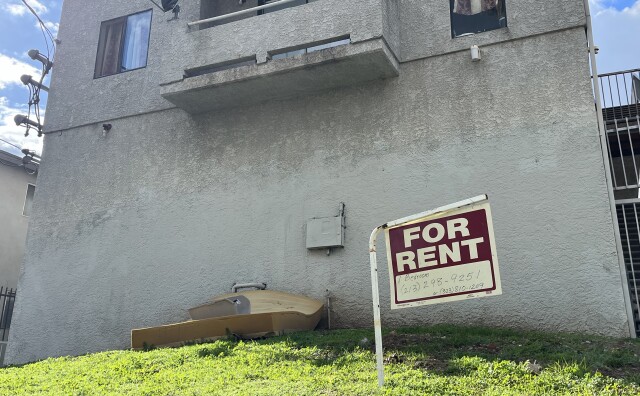As LA Evictions Rise, City Controller Releases Map Showing Where Renters Are Getting Pushed Out

With many of L.A.’s COVID-19 renter protections now gone, evictions in 2023 have been rising well above pre-pandemic levels. Due to new rental housing regulations put in place by L.A.’s city council earlier this year, City Controller Kenneth Mejia is now able to track where those evictions are playing out across the city.
Mejia’s office released a new data set on Monday showing that Hollywood, Fairfax and Downtown L.A. have had particularly high numbers of eviction filings. And about 13% of eviction notices in the data are for amounts less than $1,534, the fair market rent for an L.A. studio apartment, raising questions about compliance with a new city tenant protection rule.
“We hope this map and analysis informs policy makers and the public about our city’s housing/eviction crisis,” Mejia tweeted, linking to the data’s release.
Since late January, L.A. landlords have been required to send the city’s housing department written notice every time they file an eviction against a tenant. The data released by Mejia’s office shows that from Jan. 27 to July 31, the housing department received 39,677 eviction notices.
The vast majority of those notices (96%) have been for non-payment of rent. During the pandemic, the city’s tenant protections gave legal defenses to renters who couldn’t pay on time due to economic harms brought on by COVID-19. But those non-payment protections expired on April 1 — meaning tenants could face eviction for failing to pay rent from that point on.
Hollywood, Downtown L.A. and Fairfax are hard hit
Evictions have been filed all across the city in recent months, but the data shows some areas receiving particularly high filing volumes. ZIP codes in Hollywood (90028), Fairfax (90036) and Downtown L.A. (90015) have received the highest number of evictions.
City council districts with the highest number of eviction filings include Councilmember Kevin de León’s district 14, Councilmember Hugo Soto-Martinez’s district 13 and Councilmember Katy Young Yaroslavsky’s district 5.
Landlord groups have long complained that the city’s non-payment protections allowed tenants to live rent-free for years. But the housing department data reveals very few examples of tenants racking up huge debts. Only about 6% of non-payment eviction notices were for amounts above $10,000.
Instead, the data shows that the median amount owed in non-payment cases is $2,678.84, suggesting that most defendants are only a couple months behind on rent.
City leaders are currently considering a policy that would provide free attorneys to many renters in eviction court, but that plan is still in early stages.
With homelessness in L.A. rising 10% over the past year according to a recent count, Mayor Karen Bass has said that the possibility of more tenants getting evicted makes her “concerned that we're going to have another spike in homelessness.”
Are new eviction rules working?
Just before local COVID-19 protections expired, the L.A. city council passed a host of new tenant rights, seeking to prevent the “eviction tsunami” renter advocates worried was coming.
On March 27, one of those protections took effect: L.A. renters can now defend themselves against eviction if they’re behind by less than one month’s worth of “fair market rent” as determined by the U.S. Department of Housing and Urban Development.
But about 13% of non-payment eviction notices in the data are for amounts less than $1,534, the fair market rent for an L.A. studio apartment, raising questions about compliance with the city’s new eviction protections.
Notably, the data released by Mejia’s office pre-dates another huge change in L.A. housing policy. On Aug. 1, just after this data set ends, renters in the city faced a deadline to pay back all the rent they had missed during the first 19 months of the pandemic.
Many tenants said they were unable to repay their pandemic rent debts by Aug. 1. But little financial help has been available to them. Only a new trove of data can show whether the repayment deadline triggered another spike in eviction filings.
-
In her first public statements since controversy erupted over millions of unaccounted for tax dollars, Rhiannon Do says she’s no longer with the O.C. nonprofit Viet America Society. She also says she never had a leadership role. Public documents show otherwise.
-
The severe lack of family friendly housing has millennial parents asking: Is leaving Southern California our only option?
-
The city passed a law against harassing renters in 2021. But tenant advocates say enforcement has been lacking.
-
The Emergency Rental Assistance Program will provide up to three months of support to families with unpaid rent or at risk of becoming unhoused.
-
Now that L.A. officials know who landlords are trying to evict, city workers are showing up at renters’ doorsteps to offer help.
-
Allowable rent hikes depend on where you live, and in what type of building. Here’s your guide to figuring it all out.








